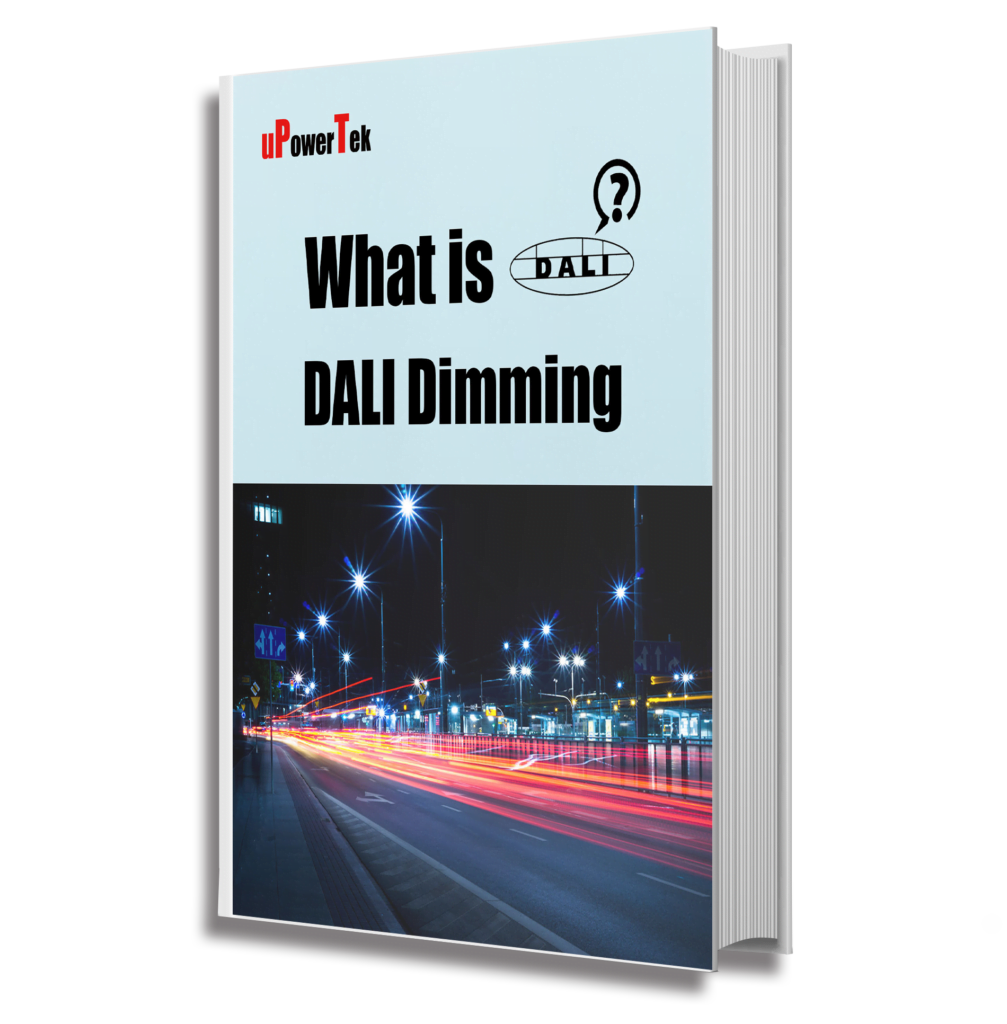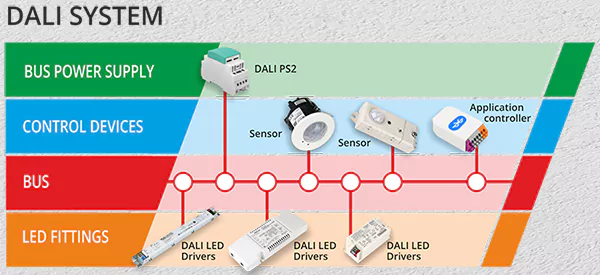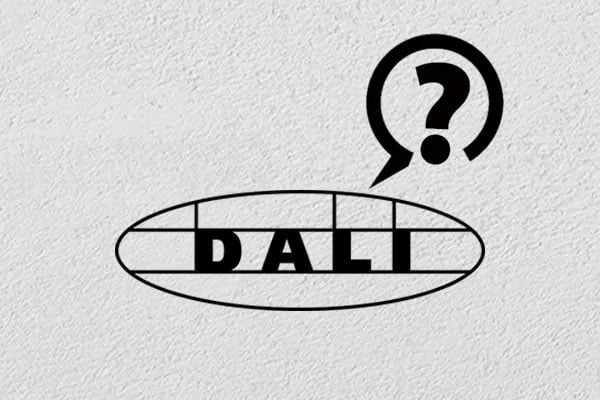Flexible and intelligent lighting controls, those are some of the features that we always dream of in lighting system.
Can the DALI dimming system achieve the same?
And what does it entail? Is it cost effective?
Well, don’t worry because this article is going to paint you that and much more.
How Well Do You Understand DALI Dimming?
In simple terms, DALI is a digital way of managing modern lighting. You can as well distinguish it as Digital Addressable Lighting Interface (DALI). It is a network control system that is built on two main electronic concepts:
- Open Standard Protocol meaning that any manufacturer can use it. It’s an IEC60929 standard protocol that developers modified over time to IEC62386. Therefore, it’s now possible for all DALI components of a lighting system from different manufacturers to work together as long as they contain the DALI logo.
- 2-Way form of digital communication DALI systems use digital signalsto transfer commands from the control systems to the luminaire and back. Note that a luminaire consists of the LED drivers and the LEDs. Picture this, you can talk to the LED luminaires, and they can talk back to you as well by the DALI controlled drivers.
How Did DALI Come About?
DALI was born during the late 1990s. Companies that make up the IEC invented it in a bid to upgrade the existing 0-10V. This 0-10 V form was not flexible. Therefore IEC (International Electronic Commission) evolved DALI to enable users to alter or redesign their lighting.
Are there any upgrades? Well, during its inception, DALI was defined in IEC60929 by the IEC. Over time it has been modified to the current 2020 version, which is defined in IEC62386. Today, this latest version is the DALI-2, while the previous was only DALI.


Download this page as a PDF
To save you time, we have also prepared a PDF version containing all the contents of this page, only leave your email and you will get the download link immediately.
How Does DALI dimming Work?
Imagine this, you tell all the lights in a large room to switch off, and they do so, and they also communicate back to you a fault with any of the single lights. The same applies to other lighting commands and not just the switching on and off. How does DALI achieve this?
This system consists of a bus that connects an application controller to a network of LED drivers and ballasts. The bus transmits the information from the controller to the LED drivers and ballasts. Sounds too general right? Okay, you will need input devices such as switches and sensors to issue your command to the controller.

These input devices do not communicate directly with the application controller. Instead, they use 24-bit data frames.
Each LED driver and dimmable LED bulb requires a unique address so that the system can identify and operate them individually.
Therefore, when you issue a command to the input devices, they transmit it to the application controller using the 24-bit data frames. The application controller will then issue a 16-bit command to the control gears that finally informs the necessary luminaire to follow the instruction.
Since the system is 2-way, the controller can communicate to you information from the luminaire. One network is usually enough for relatively small areas that do not require several lighting circuits. Otherwise, you’ll need a series of interlinked networks for larger spaces.
Where is it Commonly Used?
DALI is a popular lighting control option for restaurants and hotels, office premises, large domestic settings, and other commercial settings. You can also do a simple installation for small rooms and small buildings that require a basic DALI system.
Grow/horticulture lighting is a developing market that can benefit a lot from DALI dimming control. uPowerTek provides you with a wide range of DALI dimmable drivers that accurately addresses such specific lighting controls.


When Should You Install it for Best Results?
Most experts agree that you should install DALI lighting controls in your buildings during new construction. When you do it during a retrofit, you will require control circuits that would otherwise be a non-requirement during new construction.
How is DALI System Wired?
Is the DALI wiring polarity sensitive? The simple answer is no. The two-way bus transmits digital signals from one point to another. Such digital signals give it the potential to have both negatively and positively polarized wires. However, the connection has to be indifferent, requiring the control gears to be free from polarity.
Do you need to shield the DALI wiring? You see, the DALI bus is relatively robust when you expose it to electrical interference due to its two capabilities:
- A relatively slow data rate of (1,200 baud)
- A relatively high bus voltage i.e. 16V
These two allow the bus to have a large tolerance of voltage fluctuation. Therefore, you don’t need any shielding.
What topology should you apply? DALI works well with star, tree/line, bus, or any combination of these topologies. Unlike other lighting systems, you won’t need a wiring group for your DALI system. Therefore, you will connect all the wires in parallel to the bus.
What Components Make Up the DALI Dimming System?
Take note of:
- DALI bus is a 2-wire that transfers information between the application controllers and the application receivers.
- LED fittings that comprise all the light fittings, such as the LED drivers and LEDs. Go for DALI drivers, especially the newer DALI-2 version, for its excellent new features. You can find high-quality DALI-2 dimmable drivers from here.
- Input devices such as the switches and the lighting control desks
- Application controllers that interpret your command and transmit necessary instructions to the control gears
- Bus power supply unit The bus requires power to send and receive instructions. It requires approximately 16 V when it transmits no information and more when it transfers any information.
What’s the Difference between DALI and 1-10 V
Despite the many differences, these two can also similar. For example, many manufactures can offer you a wide range of lighting control devices such as LED drivers that contain both DALI and 1-10 V interfaces. Their main differences include:
| Items | DALI | 1- 10 V |
|---|---|---|
| Communication | It’s digital | It’s analogue |
| Control Functions | Offers a wide range of functions such as emergency light testing and feedback, colour-changing apart from the normal on/off switching and simple dimming. | It only offers the switching on/off and simple dimming functions. |
| Interoperability | DALI dimming curve is standardized, meaning that you can use drivers from different manufactures on the same diming channel for consistent results. | Its curve is non-standardized. Therefore when you use different brands of drivers on the same dimming channel you can end up with inconsistent diming results. |
| Addressability | It can respond to commands sent to different addresses/ devices. Therefore, you can enjoy features such as grouping, scene-setting and configuring your light fittings to match your room layouts. | It’s not addressable. Therefore you cannot enjoy the other features. |
Are all DALI Products Compatible with Each Other?
Since its inception, the original version of DALI had incompatibility issues. Its digital transmission units had 16 bits, 8 bits for the command and 8- bits for the address. Such incompatibilities were due to limited commands and lack of collision detection when technicians used different DALI devices in the same circuit.
However, the new DALI -2 allows you to use DALI and DALI-2 in the same circuits. Different manufacturers no longer need to make adjustments to the DALI systems to deal with incompatibilities. Remember that this compatibility works under some IEC restrictions.
Here is the DALI related contents shown in uPowerTek driver datasheet, which is compatible with DALI standards.


Want to read it later?
To save you time, we have also prepared a PDF version containing all the contents of this page, only leave your email and you will get the download link immediately.
Should You Consider DALI Dimming?
It’s no doubt that the DALI dimming system is the modern, desirable lighting control. It’s invaluable to both small and large-scale enterprises due to its scalability and flexible management. DALI also comes with its disadvantages. Therefore before you go for this system, consider the following advantages and disadvantages:
Advantages of DALI Dimming Control
- Interoperability DALI, as an open protocol, allows you to use devices from different manufactures in the same connection without getting inconsistent results. Furthermore, you can upgrade your system with new ones when they hit the market.
- Simple Installation DALI’s five-wire system does not require you to keep up with zoning and track of control wires like you do in a relay system. This system has two wires that go in and out and everywhere in your electrical circuit.
- Central Control System you can control the lighting features for two or more settings using one system. Thus, for your large commercial buildings, you can tailor lighting presets for peak demands, multi-scene venues, and even save energy.
- Reliable Monitoring System DALI’s 2-way feature allows you to access accurate and up-to-date information on your circuit components. Furthermore, you can monitor the state and energy use of individual lights.
- Programmable Lighting just like the other modern systems, you can tailor your lighting to meet your space requirements. For example, you can adjust the daylight lighting levels in your room depending on the amount of sunlight that gets in.
- Convenient reconfiguration if you need to change or upgrade your lighting after some time, you will program the lighting to operate as per your needs. You don’t need to rewire the circuitry, tear up the ceiling, and stuff. You can do the programming using software.


Disadvantages of DALI Dimming Control
- High Initial Cost the costs of controls can scare you away especially, during your initial setups. However, with time you won’t incur the high operational costs that other lighting systems require.
- Regular maintenance DALI system requires you to create a database that associates each LED’s address to the control devices that operates them. This system not only requires you to design them but also to maintain them regularly for efficient performance.
- Self Install DALI seems to be a straightforward concept in theory. However, you can never install it by yourself. You will need a custom installer since design, installation, and programming seems more complex.
DALI as A Worthwhile Investment
Despite the few drawbacks, DALI is undeniably an investment in lighting projects such as horticulture lighting. uPowerTek offers you a wide range of such DALI dimmable drivers. You can count on the DALI dimming system for an intelligent lighting design that redefines the word beautiful in your space.






